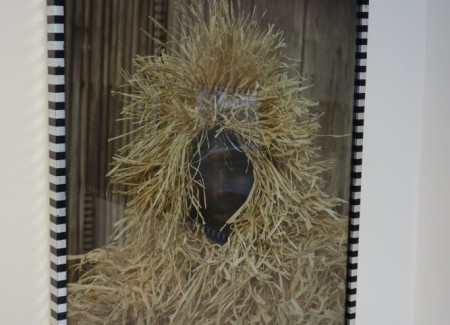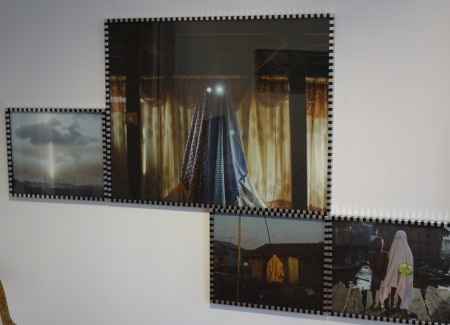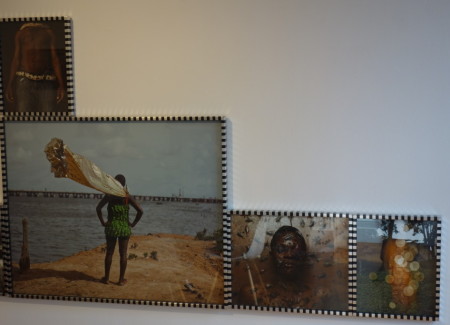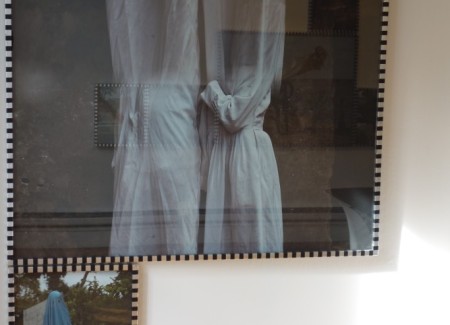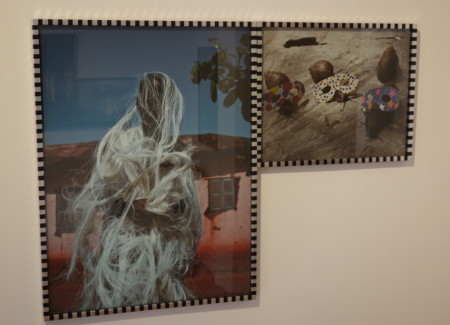JTF (just the facts): A total of 14 color photographs, unmatted and displayed in custom black and silver striped frames, and hung against white walls in the main gallery space and the entry area. All of the works are digital c-prints, made in 2014. The works are available in three sizes: 40x50cm, 80x100cm, and 110x137cm, all in editions of 7+1AP. (Installation shots below.)
Comments/Context: While it isn’t entirely obvious, it’s possible to see documentary photography and active recreation as two sides of the same coin, each pushing similar raw material to divergent but often parallel artistic ends. For one, the facts are simply the facts, and the stories that emerge from those facts are open to framing but are largely rooted in a version of the so-called objective truth; for the other, the facts are basis for something deliberately imaginative, and the stories that emerge from those facts can wander in any number of interpretive directions. The critical difference lies in the way the facts are seen – are they a strict and limiting end point or an open ended place to begin?
For the Spanish photographer Cristina de Middel, documentary-driven recreation has become a signature working style, and over the past few years, she has tested its boundaries in a succession of highly original projects. Historical documents and texts (both real and fabricated) have provided much of her initial inspiration – emails from Internet scammers, documents from the overlooked 1960s-era Zambian space program, Mao Tse-tung’s iconic Little Red Book, journals from a failed 1911 North Atlantic discovery expedition – and de Middel has liberally expanded on and transformed each archival/literary source, blurring the lines between photographic fact and fiction.
The fanciful and the implausible have often informed de Middel’s conceptual vision, and several of her projects have explored an evolving photographic version of magical realism. This mixing of the real world with the subtly fantastic has infused her imagery with an edge of smart social and political commentary. From the contrasting combination of her snapshots from contemporary China and a wryly censored version of the icon of Communist sloganeering to the optimistic earnestness of her improvised astronaut training in the African desert, each series has offered a sophisticated twist on straightforward realism.
De Middel’s newest project This is What Hatred Did continues in this artistic pattern. It uses Amos Tutuola’s groundbreaking 1964 novel My Life in the Bush of Ghosts as its source material, applying its magical story of a young Nigerian boy who runs away to the bush to escape attacking soldiers to everyday life in Makoto, a notorious modern day slum in Lagos. In many ways, this series is her most overtly cinematic and performative, in that she has actively engaged with the neighborhood’s residents to re-enact various scenes from the book. The resulting pictures have the feeling of visual fables or improvised folk tales, like the acting out of traditional stories that have been retold and passed down from generation to generation.
While it is impossible to know the exact context of de Middel’s images without digging up a copy of Tutuola’s book and matching up the passages, it’s clearly a world with plenty of ghosts and spirits running around in broad daylight. These are the makeshift sheet-ghost variety with two cutout eyes, seen wandering in the streets, tending a goat, holding flowers, and generally going about their business just like everyone else. Only when their eyes glow with brightness do these spirits seem unexpectedly malevolent or angry; mostly they seem like integrated (if mute and sometimes invisible) members of the larger ancestral community.
Other spirits on the loose are quirkier and less obviously benign. There’s the wig faced man who lives in the dense creeping greenery, the man covered in engulfing swirls of tangled silver hair, and the man with the spiky straw body. Each seems like the kind of scary presence that might be encountered in the shadows and off the well worn footpaths, the kind of bogeymen that linger in lairs and have special powers.
De Middel gets a bit more overtly mythical in her still lifes and single frame anecdotes. Snails wear painted eye masks, lightning strikes are thick and straight like arrows thrown from the sky, and a boy uses a burly snake as a belt. Each picture is a small story, an allegorical lesson, or an eye-opening tale of unexpected childlike weirdness, the everyday turned into the otherworldly by a fertile imagination. A woman disappears into a cloud of sparkling pinpricks of light, like fairies or bees or fireflies. A boy wakes up covered in a blanket of wiggling insects. And a magic silver cape seems ready to jump into flight. Up close, the obvious poverty of the floating shacks of contemporary Makoko is offset by a deeper sense of wide-eyed wonder, where joy and fear tussle in the back alleys.
De Middel has tried to tie a line through the pictures using an innovative hanging style that attempts to control the visual progression from image to image, but the larger episodic narrative and its many echoes and repetitions will likely better express itself in photobook form (apparently to be published soon by Editorial RM). Then the whole fabulous story will coalesce with more ease, each page turn adding to the building mood. On the wall in this townhouse setting, the hybrid reality doesn’t quite come together with as much force, and this particular hanging, spread across several small walls and disjointed hallways, meaningfully misses a chance for a more integrated and immersive experience. The suspension of disbelief required for magical realism to fully succeed is interrupted by the brownstone-style installation.
With The Afronauts, Cristina de Middel came out of nowhere and took the photography world by storm. Since that time, she has delivered a selection of well-crafted and thought provoking projects that have proven her work to be far more than a one hit wonder. This is What Hatred Did is a solid addition to that resume. It is further evidence that she has built a consistent photographic voice that is both warmly intelligent and quietly conceptual, one that has room for innovative cleverness and subtle humor. Her work offers a much-needed exit door from the suffocating deadpan investigation of the medium itself, a secret passageway to idea-driven, contextually-rich photography that is crafted with a dash of something memorably enchanting.
Collector’s POV: The works in this show are priced based on size, in rising editions. Initial prices are $1500 (for 40x50cm), $4000 (for 80x100cm), and $8700 (for 110x137cm). De Middel’s work has little secondary market history at this point, so gallery retail remains the best option for those collectors interested in following up.
